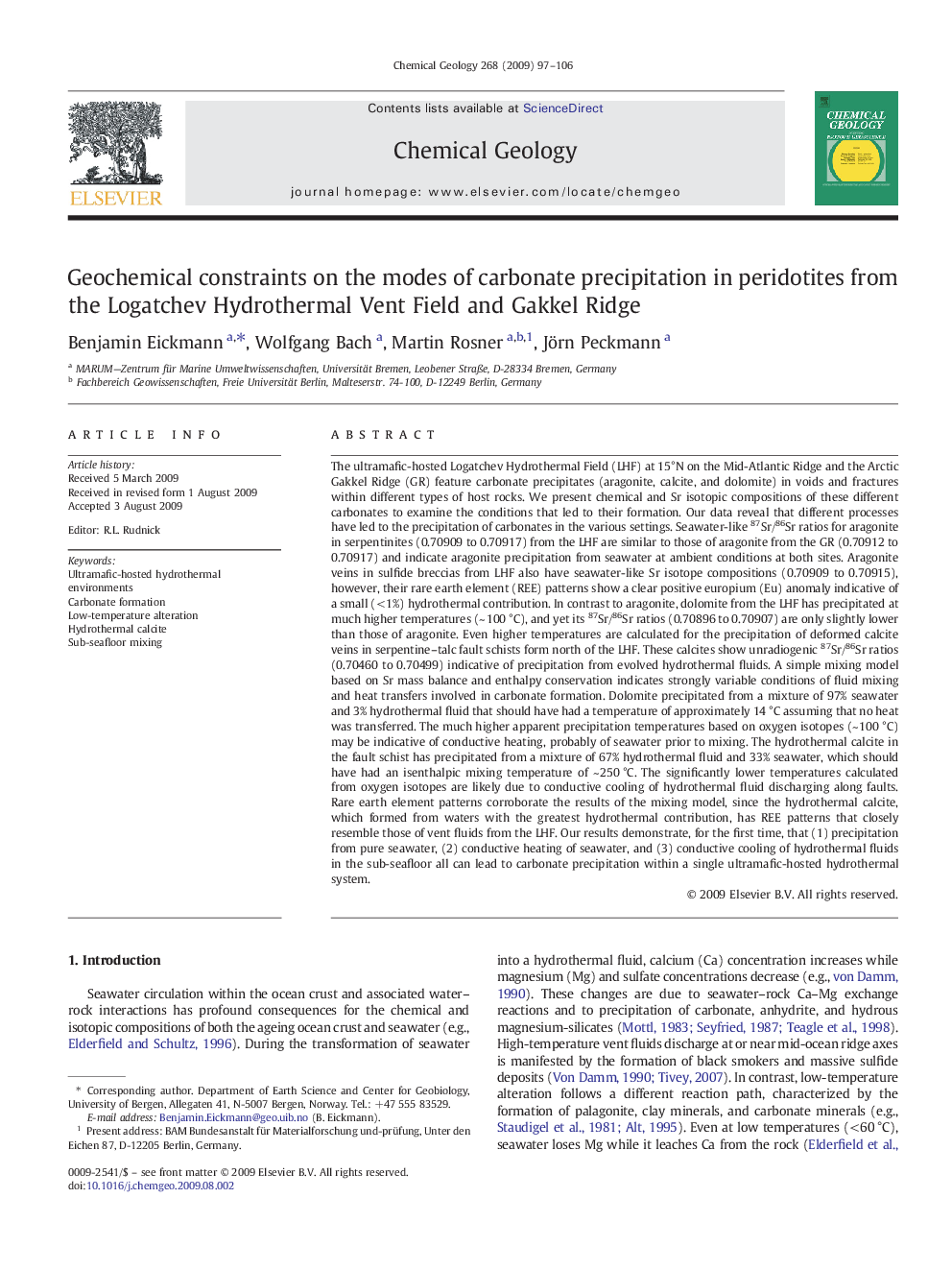| کد مقاله | کد نشریه | سال انتشار | مقاله انگلیسی | نسخه تمام متن |
|---|---|---|---|---|
| 4700268 | 1637698 | 2009 | 10 صفحه PDF | دانلود رایگان |
عنوان انگلیسی مقاله ISI
Geochemical constraints on the modes of carbonate precipitation in peridotites from the Logatchev Hydrothermal Vent Field and Gakkel Ridge
دانلود مقاله + سفارش ترجمه
دانلود مقاله ISI انگلیسی
رایگان برای ایرانیان
کلمات کلیدی
موضوعات مرتبط
مهندسی و علوم پایه
علوم زمین و سیارات
ژئوشیمی و پترولوژی
پیش نمایش صفحه اول مقاله

چکیده انگلیسی
The ultramafic-hosted Logatchev Hydrothermal Field (LHF) at 15°N on the Mid-Atlantic Ridge and the Arctic Gakkel Ridge (GR) feature carbonate precipitates (aragonite, calcite, and dolomite) in voids and fractures within different types of host rocks. We present chemical and Sr isotopic compositions of these different carbonates to examine the conditions that led to their formation. Our data reveal that different processes have led to the precipitation of carbonates in the various settings. Seawater-like 87Sr/86Sr ratios for aragonite in serpentinites (0.70909 to 0.70917) from the LHF are similar to those of aragonite from the GR (0.70912 to 0.70917) and indicate aragonite precipitation from seawater at ambient conditions at both sites. Aragonite veins in sulfide breccias from LHF also have seawater-like Sr isotope compositions (0.70909 to 0.70915), however, their rare earth element (REE) patterns show a clear positive europium (Eu) anomaly indicative of a small (< 1%) hydrothermal contribution. In contrast to aragonite, dolomite from the LHF has precipitated at much higher temperatures (~ 100 °C), and yet its 87Sr/86Sr ratios (0.70896 to 0.70907) are only slightly lower than those of aragonite. Even higher temperatures are calculated for the precipitation of deformed calcite veins in serpentine-talc fault schists form north of the LHF. These calcites show unradiogenic 87Sr/86Sr ratios (0.70460 to 0.70499) indicative of precipitation from evolved hydrothermal fluids. A simple mixing model based on Sr mass balance and enthalpy conservation indicates strongly variable conditions of fluid mixing and heat transfers involved in carbonate formation. Dolomite precipitated from a mixture of 97% seawater and 3% hydrothermal fluid that should have had a temperature of approximately 14 °C assuming that no heat was transferred. The much higher apparent precipitation temperatures based on oxygen isotopes (~ 100 °C) may be indicative of conductive heating, probably of seawater prior to mixing. The hydrothermal calcite in the fault schist has precipitated from a mixture of 67% hydrothermal fluid and 33% seawater, which should have had an isenthalpic mixing temperature of ~ 250 °C. The significantly lower temperatures calculated from oxygen isotopes are likely due to conductive cooling of hydrothermal fluid discharging along faults. Rare earth element patterns corroborate the results of the mixing model, since the hydrothermal calcite, which formed from waters with the greatest hydrothermal contribution, has REE patterns that closely resemble those of vent fluids from the LHF. Our results demonstrate, for the first time, that (1) precipitation from pure seawater, (2) conductive heating of seawater, and (3) conductive cooling of hydrothermal fluids in the sub-seafloor all can lead to carbonate precipitation within a single ultramafic-hosted hydrothermal system.
ناشر
Database: Elsevier - ScienceDirect (ساینس دایرکت)
Journal: Chemical Geology - Volume 268, Issues 1â2, 20 October 2009, Pages 97-106
Journal: Chemical Geology - Volume 268, Issues 1â2, 20 October 2009, Pages 97-106
نویسندگان
Benjamin Eickmann, Wolfgang Bach, Martin Rosner, Jörn Peckmann,